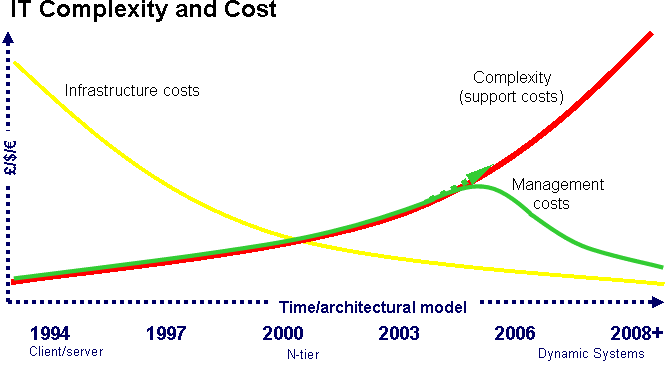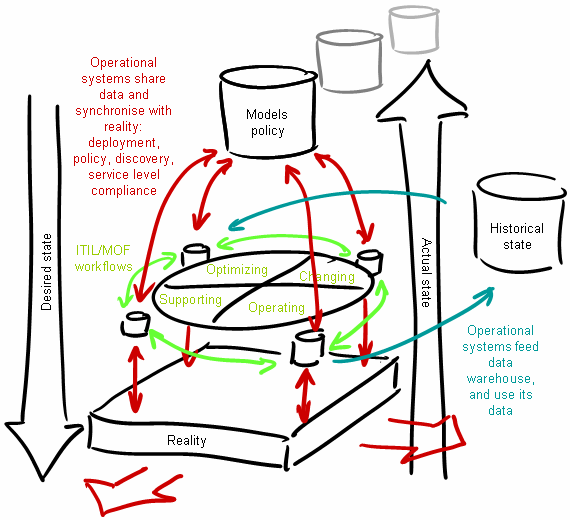The Microsoft Management Summit is one of Microsoft’s annual conferences and last Friday, the most popular presentations were re-run in the UK. Microsoft clearly took the event seriously, bringing across from Redmond the Corporate VP for Enterprise Management (Kirrill Tatarinov); the Systems Management Server and Operations Manager Program Managers (Bill Anderson and Vlad Joanavic); and a Director of Product Management for Enterprise Management (Michael Emanuel).
Largely due to the quality of the speakers, the event was well worth attending – particular Michael Emanuel’s Dynamic Systems Initiative (DSI) presentation. I’ve seen DSI presentations before, but this was inspirational – largely due to the charismatic way in which he described the differences between desired and actual states as “ought-ness” and “is-ness” (with associated “was-ness”, “could-ness”, “good-ness” and “should-ness”).
I’ll try to explain it all below (with a few additions from previous DSI presentations)!
It is generally regarded that infrastructure costs fall rapidly whilst performance rises (a derivative of Moore’s Law). What is less well known is that as the infrastructure costs drop, the support costs associated with supporting systems rise. Typically, 70% of an organisation’s IT budget is spent on maintenance, with just 30% on new systems. The trouble is that our increasingly well connected, but highly distributed IT systems are becoming incredibly complex. Add to that, the organisational complexity with infrastructure architects, developers, systems administrators, service architects, business stakeholders, testers, IT management and even outsourced/offshore partners – wouldn’t it be great to do something to control the management costs and let them track the decreasing cost of the infrastructure?

Businesses tend to be dynamic. All too often, IT is not. Microsoft’s answer is the DSI, which is about helping IT organisations to capture and use knowledge to design more manageable systems and automate ongoing operations, resulting in reduced costs and more time for IT to focus on what is most important to the business.
It sounds logical enough… so why don’t we do this already? Basically because IT infrastructure architects and IT operations managers don’t tend to talk the same language! In general, designers think about scalability, security and identity but gloss over the management element. With 80% of the cost of a project committed by design decisions at the end of the design phase (but only 8% of the cost incurred), it is all too often too late to change things when they reach production and don’t fit well within an operational model. DSI is about encouraging a full lifecycle view so that operational awareness can be built into applications and services right from the initial design, using models to capture knowledge (i.e. bottling what is known for re-use) throughout the lifecycle.
The key is that systems should be designed for operations with manageability architected into the system from the outset. To do this, there are two fundamental building blocks required:
- A generic way in which to model knowledge – the systems definition model (SDM).
- A generic way in which to communicate with a system – WS-Management.
The SDM is basically a manifest which provides a single source of information on a system, describing:
- What “it” is.
- What “it” is capable of doing.
- What “it” needs to achieve these capabilities.
WS-Management is a web services implementation of Web Based Enterprise Management (WBEM), developed as part of the Web Services Interoperability Organization’s WS-* architecture as a joint effort by AMD, BMC Software, Dell, Intel, Microsoft, Sun Microsystems and WBEM Solutions, and the first Windows implementation (WS-Management is heterogeneous) will be made available later this year as part of Windows Server 2003 Release 2 (R2).
Meanwhile, Microsoft is slowly moving the existing models within its management products over to SDM in support of the DSI and sees Visual Studio as a tool for defining the holistic structure of the application, services and system – considering management at design time to integrate service requirements during development.
By combining the application designer’s feature/functionality view of the world with the IT Operations Manager’s data centre policies and constraints, SDM models can be defined and fed through a validation process to identify errors; but a development environment in itself if not enough. Knowledge is the key to management and the diagram below shows a desired state (models, constraints, policy, prescriptive guidance, SLAs, patches) being replicated down (Emanuel refers to this as “ought-ness”) and an actual state (inventory, metrics, events, alerts, compliance, service level, results – the “is-ness”) being replicated up. The art of management is resolving conflicts between the “ought-ness” and the “is-ness” states. Furthermore, this management is not performed using an expensive tool but is actually the knowledge held by administrators and operators which needs to be re-used. The DSI vision is self-managing systems so that every application is delivered with a model which can be deployed across every Windows system.

SDM models are held in a models database and applied through each of the Microsoft operations framework (MOF)/IT infrastructure library (ITIL) workflows to synchronise with reality. Operational systems feed this information into a data warehouse which stores a point in time view of this reality (the “was-ness”). Taking this a step further, by applying “what-if scenarios” (“could-ness”) to this historic state, the potential (“good-ness”) of what should be (“should-ness”, or future “ought-ness”) can be modelled (i.e. capacity planning).
Of course, Microsoft is a product and technology company and so they have products which map on to this approach. Looking at the MOF model, each quadrant has associated products:
- Changing: Microsoft Systems Management Server.
- Operating: Microsoft Operations Manager; Microsoft System Center Data Protection Manager.
- Supporting: Microsoft Visual Studio 2005 Team System; Microsoft Business Solutions CRM.
- Optimising: Microsoft System Center Capacity Manager; Microsoft System Center Reporting Manager.
To summarise, DSI consists of a number of core technical principles:
- Software platforms and tools that enable knowledge of an IT system (architectural intent; operational environment; IT policies; resource needs; across platforms)…
- …to be captured in software models (MOM management packs; software update manifests; SDMs)…
- …that can be created, modified and operated upon across the IT lifecycle (develop, operate, analyse/act).
In terms of product, Microsoft has currently defined three waves of products to support the move to dynamic systems:
- System Center Wave 1 is happening now and consists of:
- Microsoft System Center Capacity Manager 2006 (codenamed Indy).
- Microsoft System Center Reporting Manager 2005.
- Microsoft Systems Management Server 2003 (service pack 1).
- Microsoft System Center Data Protection Manager 2006.
- Microsoft Operations Manager 2005.
- Microsoft Visual Studio 2005.
- Microsoft Windows Server 2003 R2 WS-Management.
- System Center Wave 2 should happen around 2006-2007 and includes:
- Windows Server (codenamed Longhorn).
- Microsoft System Center Capacity Manager v2.
- Microsoft Operations Manager v3.
- Microsoft System Management Server v4.
- Microsoft System Center Reporting Manager v2.
- System Center Wave 3 is due around 2008-2009, and is when the various strands of the DSI can finally be pulled together.
3 thoughts on “Microsoft’s Dynamic Systems Initiative”